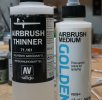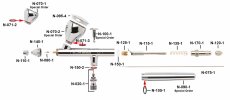Docbritofmf
Active Member
- Joined
- Jun 10, 2021
- Messages
- 266
Hey guys I could use a little assistance with my airbrush.
When I started airbrushing I messed around with a few cheap airbrushes with various success but eventually I went out and purchased a Iwata Neo CN gravity feed airbrush and a small airbrush compressor.
My over all success rate with the airbrush improved with the higher end brush and compressor however my problems started arising after few uses and cleanings.
When I started using the brush I would originally clean it out by running what ever thinner I was using for the preticular paint IE acrylic or enamel but then I started to run into feed issues were I wasn't getting a good flow from the gun tip.
I started to realize that I wasn't cleaning the gun as good as I should and found that the pipe cleaner brush kits weren't getting into the more smaller sections of it, I also found that the thinner was ruining the o rings and I was getting small leakes,
My research lead me to find out that airbrush cleaner is specifically formulated to clean and lubricate the inner components of the airbrush and prevent deteriorating o rings.
I think I'm at the point where I'm gonna have to replace some o rings and maybe some parts but I really don't know when I should be replacing things threw out the life of the airbrush aside from the obvious such as the o rings
What do you guys recommend for cleaning your airbrush when switching between colors and what do you recommend for cleaning it after your done using it for the day?
Also how often do you need to replace parts likes tips and needles? Just when they are damaged or do they eventually need replacement?
And o rings I am unfortunately not sure just how many orings and there location are in my air brush that might need replacement the store I bought the kit from seems to only sell one more two of the large o rings but I believe there were other smaller ones such as around the threaded end of the needle tip and in the crown and cap
When I started airbrushing I messed around with a few cheap airbrushes with various success but eventually I went out and purchased a Iwata Neo CN gravity feed airbrush and a small airbrush compressor.
My over all success rate with the airbrush improved with the higher end brush and compressor however my problems started arising after few uses and cleanings.
When I started using the brush I would originally clean it out by running what ever thinner I was using for the preticular paint IE acrylic or enamel but then I started to run into feed issues were I wasn't getting a good flow from the gun tip.
I started to realize that I wasn't cleaning the gun as good as I should and found that the pipe cleaner brush kits weren't getting into the more smaller sections of it, I also found that the thinner was ruining the o rings and I was getting small leakes,
My research lead me to find out that airbrush cleaner is specifically formulated to clean and lubricate the inner components of the airbrush and prevent deteriorating o rings.
I think I'm at the point where I'm gonna have to replace some o rings and maybe some parts but I really don't know when I should be replacing things threw out the life of the airbrush aside from the obvious such as the o rings
What do you guys recommend for cleaning your airbrush when switching between colors and what do you recommend for cleaning it after your done using it for the day?
Also how often do you need to replace parts likes tips and needles? Just when they are damaged or do they eventually need replacement?
And o rings I am unfortunately not sure just how many orings and there location are in my air brush that might need replacement the store I bought the kit from seems to only sell one more two of the large o rings but I believe there were other smaller ones such as around the threaded end of the needle tip and in the crown and cap


